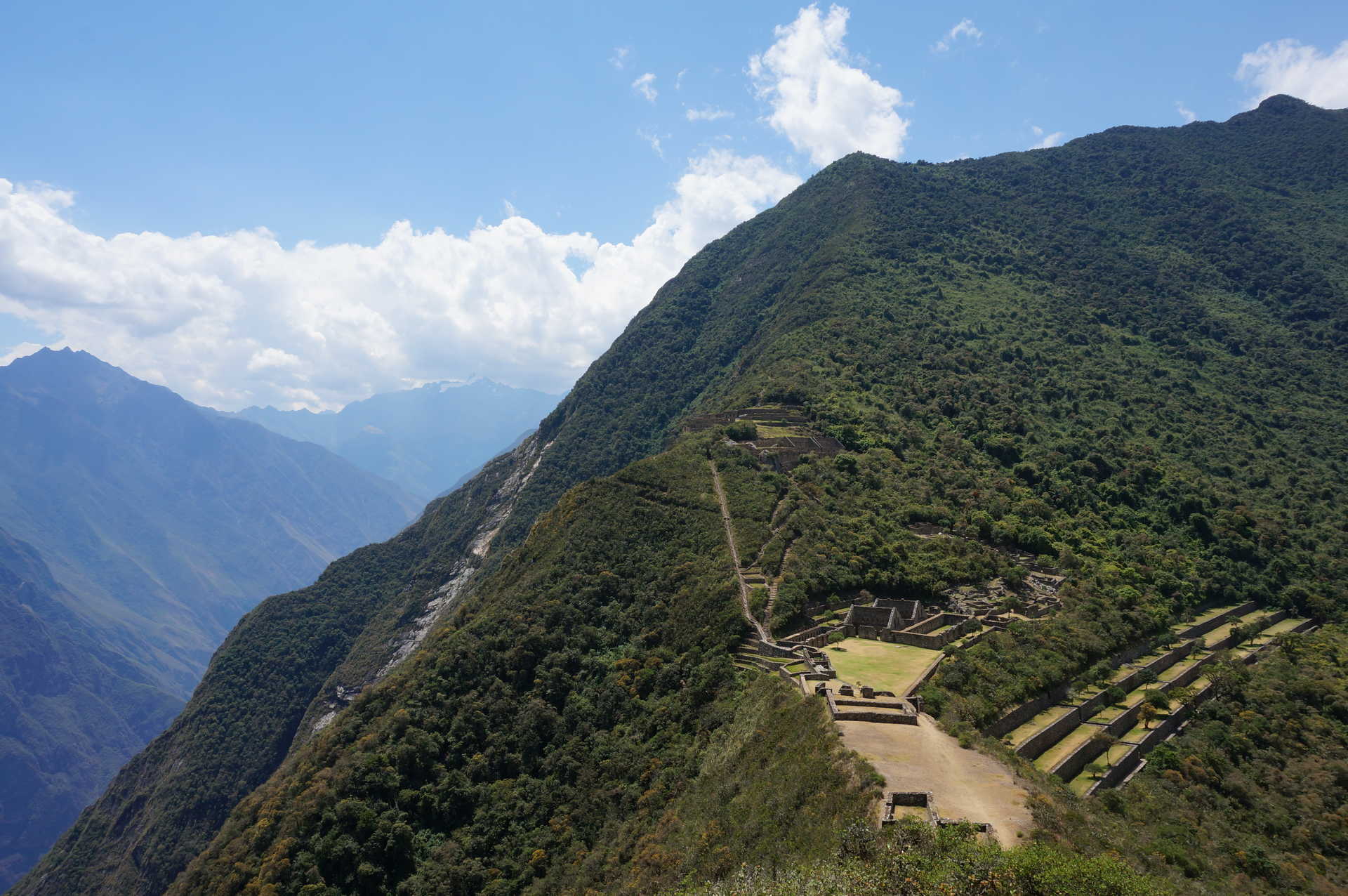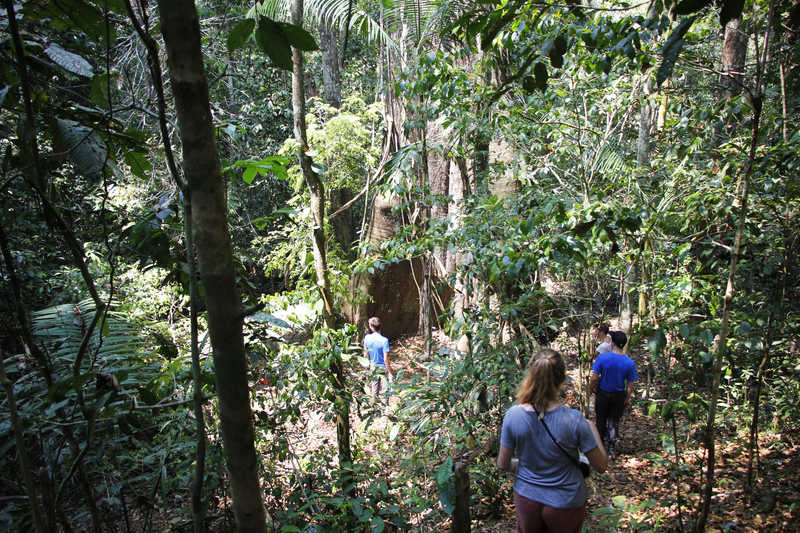The Choquequirao Trek
- Kandoo Trekking

Contact
our UK team

All trekkers need to organise their own flights to Cuzco Airport (CUZ). From the airport we will arrange an airport transfer for you.
The city of Cuzco sits at an altitude of 3400m and is a great place to acclimatise before you start your Choquequirao trek. You’ll have plenty of time to explore this charming city and soak up the local atmosphere. That evening you will meet your local Kandoo representative and have a full pre-trek briefing.
The trek starts with a 4-5 hour drive to Capuliyuc (2,800m) where we meet our muleteer team and have lunch. In the afternoon we’ll begin our trek by hiking for 3-4 hours down into the Apurimac Canyon to our first campsite at Chiquiska at 1835m. The path is straightforward with a few switchbacks and downhill all the way, and there are fantastic views of the surrounding snow peaks and Choquequirao in the far distance.
We will wake early and descend from Chiquiska further into the valley for about 1 hour before crossing the Apurimac River. Once we have crossed the river we begin a two-hour ascent to Santa Rosa, a small campsite where we can rest and refill water bottles. From Santa Rosa we continue ascending, first to Marampata (2,913m) where we will have lunch, and then onto our campsite just below Choquequirao (3,035m). The trek between Santa Rosa and Choquequirao takes between 4-5 hours and is pretty tough. There are bathrooms and cold-water showers at the Choquequirao campsite.
The archaeological complex of Choquequirao is large and can take a full day to explore properly. Archeologists have divided the site into 12 sections. You will be given a guided tour of the Citadel, visiting the ceremonial centre, main platform and the lower plaza. Towards dusk we might get lucky and spot condors that frequent this part of the region.
Today starts early with a gradual hike up and over the Choquequirao Pass at 3,300m, and then a descent into the Rio Blanco Valley (1,910m). At the foot of the valley is the river Rio Blanco where trekkers can swim before a tough and steep three-hour hike up to Maizal (3,000m).
Day 7 starts with a long climb up to the Victoria Pass (4,200m) where we will see original paved Inca Trails. Once over the pass we descend down towards the small village of Yanama (3,500m), where we will camp for the night.
We start the day with a climb up to the Yanama Pass (4,668m) – the highest point on the trek. From here, spectacular views of Sacsayraoc peak dominate, and once we’ve crossed the pass, the largest peak in the area, Salkantay comes into view. From the pass the trail descends to the small village of Totora.
We start the long, winding descent of nearly 2,000 m to the Totora River. Trekking poles to reduce the impact of the descent on your knees come in handy throughout this day. We follow the Rio Santa Teresa for around 6-7 hours, trekking through cloud forest with a huge variety of butterflies, birdlife and vegetation. We will camp on the outskirts of Lucmabamba village. This campsite is located in a coffee farm and you will be able to taste the best coffee in Peru! There is also an option to visit the hot springs in Cocalmayo.
From Lucamabamba the trail ascends for 4 hours through coffee and fruit plantations and cloud forest to a newly discovered Inca site called Llactapata. We will have an amazing view of Machu Picchu before the trail descends for two hours into the Urubamba Valley to the Hydroelectric Station where we catch the train to Aguas Calientes. You will overnight in a hotel and have a chance to swim in the town’s famous hot springs.
Today, you will be given a guided tour of the Lost City of the Incas, which will last for around 2½ to 3 hours. There is also an option to climb Huayna Picchu, the famous mountain behind the ruins, but you will need to book a permit in advance. In the afternoon, we will catch the train from Aguas Calientes to Ollantaytambo, where you will be met by our driver who will transfer you to your hotel in Cuzco.
After a much needed night’s rest, we will bid you goodbye. We will collect you from your hotel and transfer you to Cuzco Airport for your departing flight.
Staying
well-fed on your trek is absolutely vital, especially when conditions are such
that you might not want to eat or drink as much as you should. Because
so many trekkers experience a loss of appetite at altitude, our head chef has
developed special menu plans that are appealing, healthy, and filled with all
the energy you need to make it to Machu Picchu. By default, our meals include
fresh fruit and vegetables every day, as well as fresh meat and fish.
BREAKFAST
Breakfast
is usually fairly hearty. Of
course, you’ll also have hot drinks, generally a choice of tea, coffee or hot
chocolate. Let your guide know if you are still hungry, or even if you think
you could ‘pack in a few more bites’. Our cooks always try to provide more
food than necessary to ensure everyone gets a good meal.
LUNCH
Lunch
is packed for you, to carry in your rucksack.
AFTERNOON
TEA
Afternoon
Tea is served at the end of the days walking, once you get to camp. In
addition to tea and other hot drinks, there are plenty of snacks to help
restore some of the energy you’ve just burned off.
DINNER
Dinners
are quite filling. They usually begin with a nice hearty soup, and then a
main course with fresh vegetables, and plenty of rice, pasta or potatoes,
followed by a yummy dessert.
DRINKING
WATER
On
the trek, we filter and boil all the water that we give to you for drinking.
You may wish to bring purification tablets as an extra precaution but they
are not essential. Every morning we will fill up your water bottles or
hydration bladder with at least 2 litres of water.
COCA TEA
Coca
tea is thought to help relieve the symptoms of altitude sickness. In Cuzco,
all the hotels have dried leaves and hot water available throughout the day
so you can make your own tea whenever you wish.
On the trek we will take coca leaf tea bags for you.
We use only the very best high altitude
mountain tents, Eureka K-2 XT, to ensure you stay warm, dry and comfortable on
your Choquequirao
trek. Please bear in mind, these are proper mountain tents, designed to cope
with extreme conditions so don’t expect to be able to stand up and walk around
inside!
The hotels in we use in Peru all have western, flushing toilets. Whilst on the trek the toilet situation will be a little less luxurious. At camp each evening we will set up a toilet tent. This is a simple facility that provides a little privacy and comfort whilst on the trail. The toilet tent will contain a portable, sit down toilet. Whilst trekking, if you need to go you will have to find somewhere hidden, off the path and go wild. There's plenty of places to hide in the Peruvian forests!
We insist on using a high standard of
vehicle and driver for all of our transfers. In Peru it is not a legal
requirement to have seatbelts fitted in the back of vehicles, and while we try
to use vehicles that do have rear seatbelts fitted, this cannot always be
guaranteed. If you are unhappy about any aspect of the vehicle or the standard
of driving, please speak to the driver or our local office immediately.
Bag Weight: 10kg
We say goodbye to our crew at the Hidroelectrica
station, before we continue to Aguas Calientes and Machu Picchu. Any tips that you wish
to give to the cook and arrieros will
need to be carried on the trek with you.
If
you’ve decided to rent gear, then below is a list of equipment available.
Just let our team know what you’d like to hire at your Pre-Trek
Briefing.
All
payments are made locally in US
Dollars (cash only):
North
Face 0° Sleeping Bags $30
per trek
Trekking
Poles $20
per trek
Duffle
Bag $5
per trek
All
items must be packed in your main equipment bag.
They
should not be attached to the outside, as we are not responsible if items
fall off when the bags are being carried on the trek. The sleeping bags weigh
approximately 2kg each
UPPER
BODY
LEGS
FEET
OTHER
ACCESSORIES
Want to ask us a question or book a private trip? Don't hesitate to contact us!
Contact us



